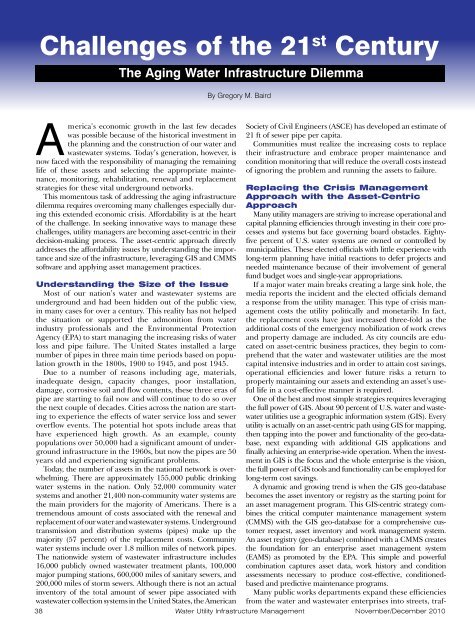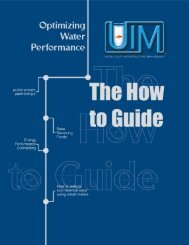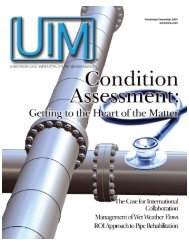Challenges of the 21 st CenturyThe Aging <strong>Water</strong> <strong>Infrastructure</strong> DilemmaBy Gregory M. BairdAmerica’s economic growth in the last few decadeswas possible because of the historical investment inthe planning and the construction of our water andwastewater systems. Today’s generation, however, isnow faced with the responsibility of managing the remaininglife of these assets and selecting the appropriate maintenance,monitoring, rehabilitation, renewal and replacementstrategies for these vital underground networks.This momentous task of addressing the aging infrastructuredilemma requires overcoming many challenges especially duringthis extended economic crisis. Affordability is at the heartof the challenge. In seeking innovative ways to manage thesechallenges, utility managers are becoming asset-centric in theirdecision-making process. The asset-centric approach directlyaddresses the affordability issues by understanding the importanceand size of the infrastructure, leveraging GIS and CMMSsoftware and applying asset management practices.Understanding the Size of the IssueMost of our nation’s water and wastewater systems areunderground and had been hidden out of the public view,in many cases for over a century. This reality has not helpedthe situation or supported the admonition from waterindustry professionals and the Environmental ProtectionAgency (EPA) to start managing the increasing risks of waterloss and pipe failure. The United States installed a largenumber of pipes in three main time periods based on populationgrowth in the 1800s, 1900 to 1945, and post 1945.Due to a number of reasons including age, materials,inadequate design, capacity changes, poor installation,damage, corrosive soil and flow contents, these three eras ofpipe are starting to fail now and will continue to do so overthe next couple of decades. Cities across the nation are startingto experience the effects of water service loss and seweroverflow events. The potential hot spots include areas thathave experienced high growth. As an example, countypopulations over 50,000 had a significant amount of undergroundinfrastructure in the 1960s, but now the pipes are 50years old and experiencing significant problems.Today, the number of assets in the national network is overwhelming.There are approximately 155,000 public drinkingwater systems in the nation. Only 52,000 community watersystems and another 21,400 non-community water systems arethe main providers for the majority of Americans. There is atremendous amount of costs associated with the renewal andreplacement of our water and wastewater systems. Undergroundtransmission and distribution systems (pipes) make up themajority (57 percent) of the replacement costs. Communitywater systems include over 1.8 million miles of network pipes.The nationwide system of wastewater infrastructure includes16,000 publicly owned wastewater treatment plants, 100,000major pumping stations, 600,000 miles of sanitary sewers, and200,000 miles of storm sewers. Although there is not an actualinventory of the total amount of sewer pipe associated withwastewater collection systems in the United States, the AmericanSociety of Civil Engineers (ASCE) has developed an estimate of21 ft of sewer pipe per capita.Communities must realize the increasing costs to replacetheir infrastructure and embrace proper maintenance andcondition monitoring that will reduce the overall costs insteadof ignoring the problem and running the assets to failure.Replacing the Crisis <strong>Management</strong>Approach with the Asset-CentricApproachMany utility managers are striving to increase operational andcapital planning efficiencies through investing in their core processesand systems but face governing board obstacles. Eightyfivepercent of U.S. water systems are owned or controlled bymunicipalities. These elected officials with little experience withlong-term planning have initial reactions to defer projects andneeded maintenance because of their involvement of generalfund budget woes and single-year appropriations.If a major water main breaks creating a large sink hole, themedia reports the incident and the elected officials demanda response from the utility manager. This type of crisis managementcosts the utility politically and monetarily. In fact,the replacement costs have just increased three-fold as theadditional costs of the emergency mobilization of work crewsand property damage are included. As city councils are educatedon asset-centric business practices, they begin to comprehendthat the water and wastewater utilities are the mostcapital intensive industries and in order to attain cost savings,operational efficiencies and lower future risks a return toproperly maintaining our assets and extending an asset’s usefullife in a cost-effective manner is required.One of the best and most simple strategies requires leveragingthe full power of GIS. About 90 percent of U.S. water and wastewaterutilities use a geographic information system (GIS). Everyutility is actually on an asset-centric path using GIS for mapping,then tapping into the power and functionality of the geo-database,next expanding with additional GIS applications andfinally achieving an enterprise-wide operation. When the investmentin GIS is the focus and the whole enterprise is the vision,the full power of GIS tools and functionality can be employed forlong-term cost savings.A dynamic and growing trend is when the GIS geo-databasebecomes the asset inventory or registry as the starting point foran asset management program. This GIS-centric strategy combinesthe critical computer maintenance management system(CMMS) with the GIS geo-database for a comprehensive customerrequest, asset inventory and work management system.An asset registry (geo-database) combined with a CMMS createsthe foundation for an enterprise asset management system(EAMS) as promoted by the EPA. This simple and powerfulcombination captures asset data, work history and conditionassessments necessary to produce cost-effective, conditionedbasedand predictive maintenance programs.Many public works departments expand these efficienciesfrom the water and wastewater enterprises into streets, traf-38 <strong>Water</strong> <strong>Utility</strong> <strong>Infrastructure</strong> <strong>Management</strong>November/December 2010
fic, highways, signs, parks, recreation equipment, airports,marinas, fleet, electric networks and other municipal functions.Not only has this produced a considerable return oninvestment and improved financial decision-making throughapplying financial metrics to planned and unplanned maintenanceactivities, but also tracking and reporting regulatoryrequirements, tests, inspections, customer requests, projectcosts and performance. This GIS-centric strategy has beenvery successful in tracking and reporting strict complianceissues as found in California and expediting federal fundingafter disasters like Hurricane Katrina.The GIS-centric strategy when applied to asset managementprovides a reduced level of frustration and complexityfrom redundant database costs and difficulties with integratingsystems. The work history alone offers a low-cost wealthof data that provides insight on when and where to applyrenewal and replacement techniques. A GIS-centric strategyalso allows for land planning activities such as permitting,licensing, general and specific plan updates, and hydraulicmodel development. Additional asset management analysiscan be performed through a simple spreadsheet downloadfrom the CMMS to more sophisticated and advanced analyticaltools requiring interfaces and integration protocols.Capital plan projection tools should not be aged-based only,but take into consideration the condition of the asset. Assetmanagement analytical tools should avoid short cuts such asapplying original cost depreciation curves; it may work foraccountants, but managing and financing assets requiresknowing the replacement costs and a likely decay curve.Understanding the Costs ofReplacementUnder the 1996 amendments to the Safe Drinking <strong>Water</strong> Act,EPA is required to conduct an infrastructure needs assessmentevery four years. These estimates will only increase each year. In2001, the <strong>Water</strong> <strong>Infrastructure</strong> Network (WIN), a consortium ofindustry, municipal and non-profit associations, estimated up to$1 trillion over a 20-year period was needed for water and wastewatersystems, when both capital investment needs and the costof financing were considered. In the last 10 years, the requiredinvestments have not been made. In 2009, ASCE gave America’sdrinking water infrastructure a D-minus.In 2001, the American <strong>Water</strong> Works Association (AWWA)studied the replacement costs for 20 large utilities across thenation. Over the next 20 years, utilities will experience a significantincrease in renewal and replacement costs, which inturn will add additional pressure to increase rates significantly.The test for rate approving authorities will be whether they willallow a slow, gradual annual increase or face a serious rateshock scenario to play catch-up to prevent impending failuresor fund expensive repairs after the fact. As the graph suggests,one-time fixes will not work. A sustainable, long-term strategyto effectively manage our assets is required. This strategy in allof its various forms is generally called asset management.Asset <strong>Management</strong> Is a LocalResponsibilityUtilities need know the location and condition of their assets.GIS is the best place for gathering data for all kinds of assets tobe shared system-wide. Utilities need to have a proven CMMSthat leverages GIS capabilities in order to achieve an optimizedlevel of maintenance efficiencies — the optimum solution beingGIS-centric. Many times utilities may not know all of the historicalinvestments they have made in their underground infrastructure.However, the public still maintains the expectationthat the utility or municipality understands the potential risksof system failure and has a cost-effective replacement plan.Rate-payers do not assume the price they are paying for theirwater service is for an interruptible supply. As the initial cost ofa capital replacement plan is calculated, alternative green/sustainabilityprojects and trenchless technology methods need tobe explored. Specific installation, renewal and rehabilitationtechniques like microtunneling, sliplining, static pipe burstingand horizontal directional drilling (HDD) help reduce traditionalopen-trench repair and replacement costs especially inurbanized or environmentally sensitive areas.Predictive maintenance, work history analysis, conditionassessment, and renewal and replacement programs need to beestablished as part of the operating and maintenance and capitalbudget processes as a means to set performance benchmarksto extend the life of the existing assets. Typically, municipalitiesspend a majority of the time discussing the “operational” budgetswhile not separating operating costs from maintenancecosts. Very little time is spent understanding the capital budgetsand infrastructure needs. The budget focus needs to shift to along-term, asset-centric approach in order to address the aginginfrastructure issue.A robust CMMS is the key component of developing a maintenancebudget strategy that can demonstrate the importanceof properly funding a preventative and predictive conditionedbasedmaintenance program. Providing critical maintenancebudget data shows how a utility extends the life of its assets andtherefore how it controls costs. This also helps managers toprotect their budgets from arbitrary cuts even during an economiccrisis. Traditionally, managers have not had the documentedsupport to back up the statements, “If you cut this now,you will pay more later.” Transparency in utility managementpractices, if developed in the right way, can support the costefficiencies of asset management practices being producedbehind the scenes and contained within the CMMS.Meeting the ChallengeThis era of sustainability deliberation and economic downturnis not for the weak of heart. Confident and bold new leadersneed to press forward in the wake of declining public trust,political double-talk and bureaucratic red tape. Rates will needto increase, and if affordability is truly a core concern then theremust be a change from the crisis management approach of waitingfor the next sink hole and fixing it to a predictive methodologyto avoid even higher rate increases. To make this change, themunicipal and public education of the aging infrastructure issueand the required remedies and solutions need to be systematicallyand consistently brought to their attention.The asset-centric approach with full deployment of enterprise-wideGIS functionality will help policy-makers begin toconnect the dots between water and wastewater operationswith energy, land use and ecosystem planning. This holistic,GIS-centric view of managing water resources will not onlyaddress the individual parts of aging infrastructure, but alsothe complexities of other 21st century water challenges likeclimate change, water quality and ecosystem degradation andpopulation growth. As water industry professionals, we havethe accountability and stewardship to address the issues ofthis century while balancing both cost and risk.Gregory M. Baird is Managing Director/CFO of AWI ConsultingLLC. He served as the chief financial officer of Colorado’s thirdlargest utility and finance officer of California’s 17th largest city.November/December 2010<strong>Water</strong> <strong>Utility</strong> <strong>Infrastructure</strong> <strong>Management</strong> 39








